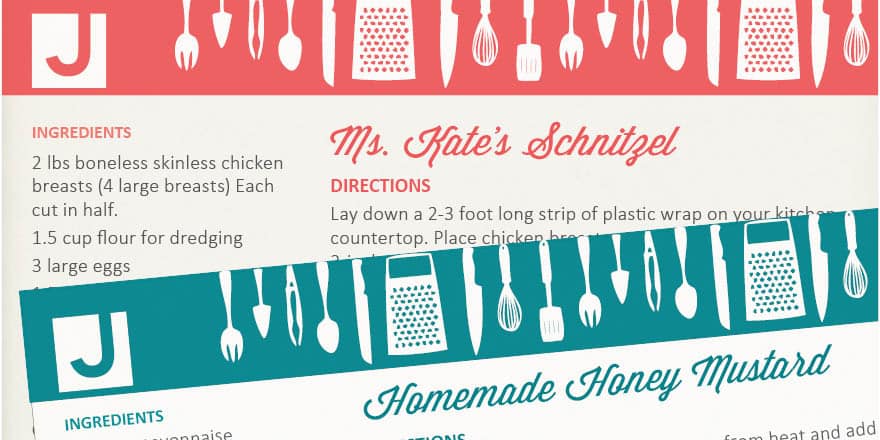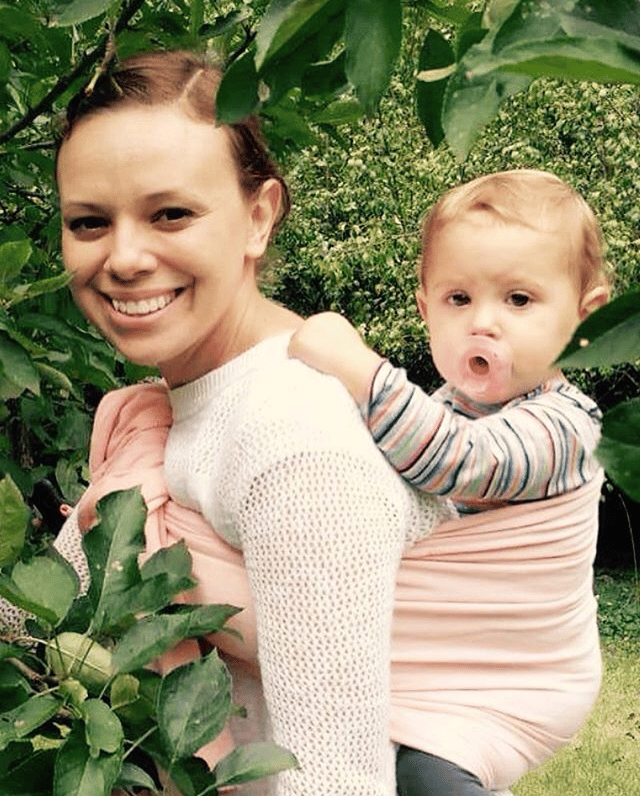Ms. Kate’s Recipe for the High Holidays

(Published Sep 17, 2019)
For ECE teacher Kate O. and her daughter Miriam, the High Holidays mean a solid month of everything being sticky, thanks to Miriam’s love of dipping apples in honey, a Rosh Hashana custom. But even more than that, Kate and Miriam love the communal aspects of celebrating the High Holidays, whether that’s hearing the shofar (ram’s horn) blown at school or during synagogue services, gathering to pick apples or bake honey cakes, or enjoying a meal with friends.
Kate also appreciates the opportunity the High Holidays provide to privately reflect on the past year. “I think about the redemptive qualities of life. How we carry on, learn from our mistakes and strive to be our best selves.”

Below is one of Kate’s favorite recipes: Schnitzel with homemade honey mustard.
A Little More about Kate
When Kate is not at the J, she likes to go hiking, spend time with friends, and still finding ways to hang out at the J- from exercising and pizza nights at the cafe, to going to cultural events hosted on campus, Kate loves to be at the J.
Favorite book: The Red Tent by Anita Diamant. Sisterhood and knowing how women relate to each other is something that has always been sacred to Kate. Every woman needs to be surrounded by like-minded individuals that understand her and help her.
Favorite quote: “You are human, you were made and build to endure and overcome.” This quote reminds Kate that there is lots of power in believing in yourself and knowing your strengths.
Favorite thing(s) about the High Holidays: Spending time with friends and family, reflecting on the past year and coming together to bring in the new.
Beginner’s Guide to the High Holidays
Rosh Hashana
This holiday is the Jewish New Year, which marks the beginning of the 10-day period of prayer, self-reflection, and repentance. It is celebrated on the first (sometimes second) day of the Hebrew month Tishri (in September). Rosh Hashana marks the first of the Jewish High Holidays. A tradition of the Jewish faith is to eat apples with honey at this time,representing hopes for a sweet new year. Another common food eaten on this holiday are pomegranates, symbolizing to be fruitful as it has many seeds.
A common greeting used for this time of year is the Hebrew phrase “L’shanah tova”, meaning “a good year”
Yom Kippur
Yom Kippur, as known as the Day of Atonement, is the holiest day of the Jewish year. It is celebrated on the tenth day of Tishri, concluding the High Holidays. This is a time for Jews to atone and repent for the past year. Jews will traditionally observe this holiday over a twenty-five hour period of fasting (if they are able) and refraining from work, spending a majority of the day in synagogue services. They will ask God for forgiveness of their sins to secure their fate and cleanse their souls of bad intentions and wrong doings.
The best greeting to say to someone observing this holiday is “have an easy fast”. If the person is not fasting, you can say “Good Yuntif” or “Yom Tov”, Yiddish and Hebrew respectively for “have a good holy day”.
Sukkot
Sukkot is celebrated on the fifteenth month of Tishri (varies from late September to late October). It is the only festival associated with an explicit commandment of rejoice. It represents a time to give thanks for the bounty of the earth during the fall harvest. At this time, Jews will build “sukkahs”, an outdoor structure with walls that are typically covered in some sort of plant overgrowth, such as palm leaves. Jews will spend much of their time in these huts in order to feel more connected with the earth and give thanks for what the earth has offered them.
To wish a happy Sukkot (or any other holiday), say “Chag sameach” (“Happy Holiday” in Hebrew).
Shemini Atzeret/Simchat Torah
Shemini Atzeret and Simchat Torah mark the end of Sukkot and the completion of the annual Torah reading for the Jews. These holidays celebrate the love for God that the Jews have and it is a time to rejoice. On Simchat Torah, after reading the final chapter of the Torah, Jews will then immediately start again at the beginning, reminding us that the Torah is a circle; it always continues even when it is over.
Following the completion of Torah readings, there is a celebration where Jews will lift up the Torah scrolls, singing and dancing with them around the synagogue.
Below is Ms. Kate’s favorite recipe for the High Holidays, a schnitzel with a homemade honey mustard! Try it for the High Holidays!
Schnitzel with Homemade Honey Mustard
Ingredients
2 lbs boneless skinless chicken breasts (4 large breasts) Each cut in half.
1.5 cup flour for dredging
3 large eggs
1.5 cup breadcrumbs
2 tbsp paprika
1 (generous and overflowing) tbsp sesame seeds
Salt and pepper
Oil for frying (pick one with a high smoke point. I prefer grapeseed)
lemon wedges for garnish
You will also need
Plastic wrap
Mallet
Skillet
Paper towels
Schnitzel Recipe
Lay down a 2-3 foot long strip of plastic wrap on your kitchen countertop. Place chicken breasts on the plastic, leaving a 2-inch space between each breast. Cover the breasts with another strip of plastic, so the meat is sandwiched between two layers of plastic. Use a mallet to pound the breasts until they are a little less than ¼ inch thick Set up three wide and shallow bowls, and a large plate on your countertop. In your first bowl, put the flour. In your second bowl, beat the eggs. In your third bowl, stir together the breadcrumbs, paprika, 1/4 tsp salt and sesame seeds in til well blended. Leave an empty plate nearby where you will place your coated schnitzels.
Pour oil into a skillet until it’s deep enough for frying (about ½ inch). Heat the oil slowly over medium. While oil is heating, dip each breast one by one into your breading bowls—first coat with flour, then with egg, then with breadcrumb mixture.
The ideal temperature to fry schnitzel is around 375 degrees F. When the oil is hot (but not smoking or splattering), fry the coated breasts in single-layer batches until they are golden brown on both sides. If your oil is at the right temperature, it should take about 4-5 minutes per side. Don’t fry more than a few breasts at a time in a regular sized skillet, or the oil temperature will drop and the schnitzels will become greasy.
After frying, set the schnitzels on a paper towel and pat them dry to soak off excess oil.
Sprinkle the schnitzels with additional salt to taste. Serve hot garnished with lemon wedges and Honey Mustard.
Homemade Honey Mustard
Ingredients
1/2 cup mayonnaise
2 tablespoons yellow mustard
1 tablespoon Dijon mustard
2 tablespoons honey
1/2 tablespoon lemon juice
Directions
Heat honey until warm and liquid. Remove from heat and add lemon juice and mix well. Whisk in mayonnaise, yellow mustard, and Dijon mustard. Serve warm or cover and chill.